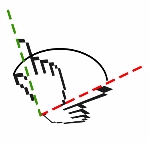|
|
|
Invited speakersDavid Gugerli (ETH Zurich, Switzerland) Mission Control I will present an insight into a book to be published in 2018. The essay tries to answer the question of how we have put the world into computers (David Gugerli, Wie die Welt in den Computer kam. Zur Entstehung digitaler Wirklichkeit, S. Fischer, Frankfurt 2018). In the mid-1960s, digital space was developing a particularly close relationship with the parts of the world that were being organized within it. At the same time, it is worth noting that computer-mediated organizations were becoming more powerful not through digital representation, but rather through digitally accelerated and enhanced interactive transactions. To prevent these transactions from degenerating into a self-referential exercise for machines, the world inside the computer had to be “synchronized in real-time” with the mundane conditions of these transactions. This could be achieved by confronting the computer with the smallest possible set of data on the one hand and by creating waiting zones for data, by preparing and analyzing data in advance, and by linking the computers immediate and distant environments through a dedicated bureaucratic machinery and through a demonstrative juxtaposition of different media layers. No example better illustrates this than NASA’s Mission Control Center in Houston. Wendy Hui Kyong Chun (Brown University, Rhode Island, USA) Proxy Politics and Algorithms: From Global Climate Change to Racial Profiling Proxies are key to modeling physical and social networks: from global climate change to network neighbors. Analyzing paleoclimate models that reveal patterns of global warming alongside models that predict a person’s race, gender and personality, this talk addresses the thorny question of proxies: their necessity and their limitations.
Jozef Kelemen (Silesian University Opava, CZ) L Systems in science and art The presentation shows a part of Aristid Lindenmayers opinions on modelling some biological phenomena by computational terms (by L systems), and provides a (very short) overview of the impact of L systems into a specific branch of computational graphics
Peter J. Denning (Naval Postgraduate School in Monterey, California, USA) The Future of Computational Thinking
Computational thinking has a long and venerable history dating back to ancient times. Computer Science and Computational Science are part of the fifth developmental stage of computational thinking. A new stage has been proposed motivated by a movement to get computer science into all schools. Once the controversies around the proposal have been settled, what does the future hold for computational thinking? We will take a look.
Frieder Nake (Universität Bremen, DE) rational.radical.emotional – An algorithmic solution of the problem of Information Aesthetics and its consequences
Information Aesthetics was the attempt to describe works of art as carriers of aesthetic information. Max Bense and Abraham Moles were its proponents. They relied on Shannon's information theory. For the first exhibition of computer art (Georg Nees, February 1965), Bense defined the inverse of analytical aesthetics as "generative aesthetics". In 1968/69 the author developed an algorithmic solution to the following problem: Given boundary conditions (feasibility intervals) for the measures of information aesthetics, determine an image that optimises the aesthetic measure (Gunzenhäuser) relative to the boundary conditions. This resulted in a probability distribution. It controlled distribution of elements of a repertoire (e.g., colours) into a grid. The grid's cells served as locations of the colours. The mathematical problem was a non-linear optimisation subject to linear constraints. The author ran a large number of experiments, two of which were realised as images to be exhibited. One of them is in Museum Abteiberg, Mönchengladbach. The talk will review assumptions, goals, and results. By its time, the project was advanced. However, the statistical approach to aesthetics is rather helpless because it reduces the image to a probability distribution. A topology generator must take over. The quadtree structure was invented for this. In final analysis, information aesthetics was a radical, but weak rational approach, missing important emotional aspects of generative aesthetics.
|


